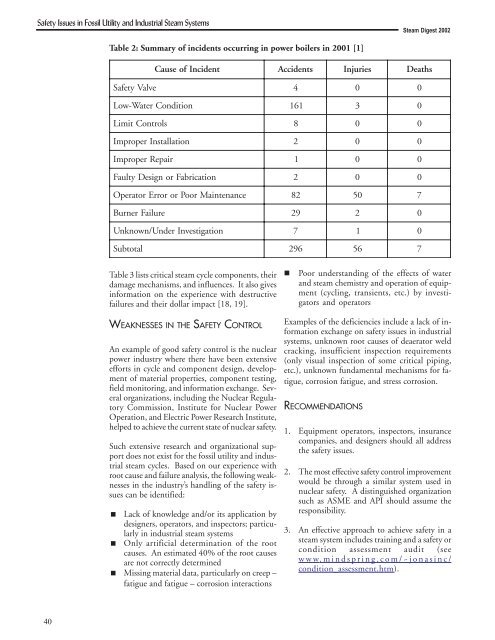Steam Digest 2002 - CiteSeerX
Steam Digest 2002 - CiteSeerX
Steam Digest 2002 - CiteSeerX
You also want an ePaper? Increase the reach of your titles
YUMPU automatically turns print PDFs into web optimized ePapers that Google loves.
Safety Issues in Fossil Utility and Industrial <strong>Steam</strong> Systems<br />
40<br />
Table 2: Summary of incidents occurring in power boilers in 2001 [1]<br />
Table 3 lists critical steam cycle components, their<br />
damage mechanisms, and influences. It also gives<br />
information on the experience with destructive<br />
failures and their dollar impact [18, 19].<br />
WEAKNESSES IN THE SAFETY CONTROL<br />
An example of good safety control is the nuclear<br />
power industry where there have been extensive<br />
efforts in cycle and component design, development<br />
of material properties, component testing,<br />
field monitoring, and information exchange. Several<br />
organizations, including the Nuclear Regulatory<br />
Commission, Institute for Nuclear Power<br />
Operation, and Electric Power Research Institute,<br />
helped to achieve the current state of nuclear safety.<br />
Such extensive research and organizational support<br />
does not exist for the fossil utility and industrial<br />
steam cycles. Based on our experience with<br />
root cause and failure analysis, the following weaknesses<br />
in the industry’s handling of the safety issues<br />
can be identified:<br />
Lack of knowledge and/or its application by<br />
designers, operators, and inspectors; particularly<br />
in industrial steam systems<br />
Only artificial determination of the root<br />
causes. An estimated 40% of the root causes<br />
are not correctly determined<br />
Missing material data, particularly on creep –<br />
fatigue and fatigue – corrosion interactions<br />
<strong>Steam</strong> <strong>Digest</strong> <strong>2002</strong><br />
CauseofIncidentAccidents Injuries Deaths<br />
SafetyValve4 0 0<br />
Low-WaterCondition161 3 0<br />
LimitControls8 0 0<br />
ImproperInstallation2 0 0<br />
ImproperRepair1 0 0<br />
FaultyDesignorFabrication2 0 0<br />
OperatorErrororPoorMaintenance82 50 7<br />
BurnerFailure29 2 0<br />
Unknown/ Under<br />
Investigation<br />
7 1 0<br />
Subtotal296 56 7<br />
Poor understanding of the effects of water<br />
and steam chemistry and operation of equipment<br />
(cycling, transients, etc.) by investigators<br />
and operators<br />
Examples of the deficiencies include a lack of information<br />
exchange on safety issues in industrial<br />
systems, unknown root causes of deaerator weld<br />
cracking, insufficient inspection requirements<br />
(only visual inspection of some critical piping,<br />
etc.), unknown fundamental mechanisms for fatigue,<br />
corrosion fatigue, and stress corrosion.<br />
RECOMMENDATIONS<br />
1. Equipment operators, inspectors, insurance<br />
companies, and designers should all address<br />
the safety issues.<br />
2. The most effective safety control improvement<br />
would be through a similar system used in<br />
nuclear safety. A distinguished organization<br />
such as ASME and API should assume the<br />
responsibility.<br />
3. An effective approach to achieve safety in a<br />
steam system includes training and a safety or<br />
condition assessment audit (see<br />
www.mindspring.com/~jonasinc/<br />
condition_assessment.htm).
















